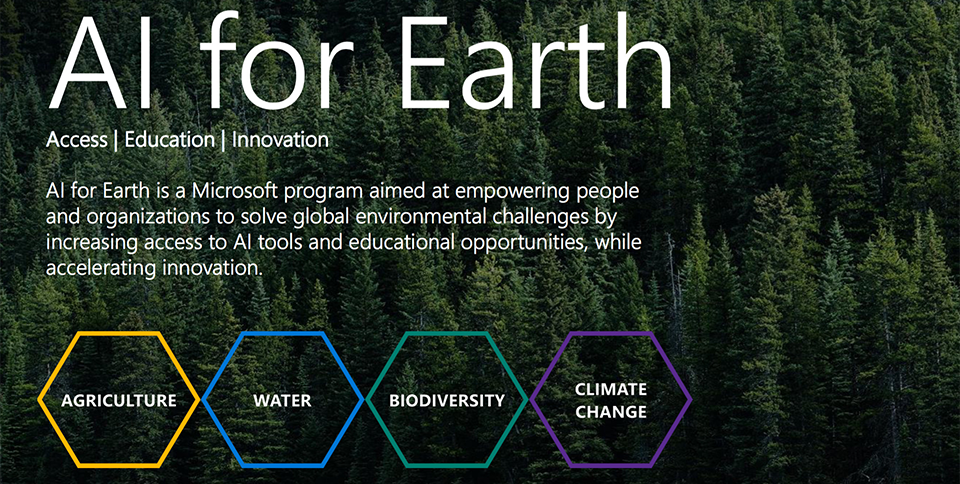Here in Canada, as we make our way through fall and toward winter, I am struck by the thought that with every passing season, we seem to be seeing more examples of extreme weather and other impacts of the changing climate all over the world.
Climate change is a real and urgent challenge, and it’s having an increasingly severe impact on our businesses, our communities, and the ecosystems that sustain them. At Microsoft, we’re doing our part by helping provide one of the most promising solutions to the challenges of monitoring, assessing and solving climate change. We call it Microsoft AI for Earth
We need better ways to analyze data about the health of our planet, including the conditions of our air, water, land and the well-being of our wildlife, in order to monitor and measure how these ecosystems are changing, and to manage their resources most effectively. Technology is helping us gather more data than ever before; but sifting, sorting and analyzing it so that we can use it most effectively to effect change is a staggeringly daunting task.
The speed and scale of change on our planet is outstripping everything – save one, and that is the speed of innovation and the rapid global adoption of new technologies.
Enter Artificial Intelligence. It is proving to be an irreplaceable tool for researchers working on climate challenges, performing mundane research tasks like image classification, species identification, and high-resolution land cover mapping. AI can take over that work, freeing up the valuable time of researchers and scientists to develop innovative, data-driven solutions.
Our goal is to put AI to work for the planet. AI gives us the capacity to monitor, model and ultimately manage the planet’s resources. And Microsoft AI for Earth is designed to democratize access to the solutions AI offers: access to technology, to training to use the technology more effectively, and ensuring that people can access the tools developed through the program, including our new APIs.
Our AI for Earth APIs are open-source. Anybody, anywhere with an internet connection can now have access to some of the most powerful technologies available today. I recommend this interview with Microsoft Chief Environmental Officer, Lucas Joppa, on his inspiration for the program.
Currently it is the nonprofits, research organizations, and communities with the fewest resources and least technological expertise that are tasked with solving massive environmental challenges—like how to nourish a growing global population with less arable land and clean water.
Microsoft AI for Earth provides select Canadian universities and other non-governmental organizations with the AI tools and technical support necessary to help them tackle issues related to water, agriculture, climate change and biodiversity.
In fact, here in Canada, we’re funding the second largest number of projects currently underway around the world. Here’s a snapshot of the work supported through Microsoft AI for Earth:
- Lakehead University: Enabling more effective biodiversity conservation and management in Ontario forests through the development of a comprehensive, up-to-date Forest Resource Inventory. This project uses AI and Microsoft Azure to exhaustively analyze aerial images of large chunks of the province’s forest lands to catalogue the range and health of natural species.
- McGill University: Developing new insights for Smart City planning, using AI and Machine Learning to assess the main factors driving climate change and their resulting impacts on urban water management.
- University of British Columbia: Analyzing and assessing trends on the quality, quantity and scope of urban greenspace in 150 cities across Canada over the past 30 years, by using AI to apply sophisticated image processing techniques.
- University of Waterloo: Using Deep Reinforcement Learning (Deep RL) algorithms to better predict the incidence and potential paths of wildfires, in order to help reduce their impact on biodiversity, habitat and agriculture.
- University of Saskatchewan: Recognizing patterns in plant genes using Deep Learning to find desirable traits for the breeding of healthier, more robust food crops.
- Leveraging Virtual Reality (VR) to explore climate data interactively from multiple stakeholders – such a satellite imagery, near fields tsunami sensor data, and crowd-sourced data on algal blooms and juvenile salmon – to determine actionable insights and trends related to climate change.
Human ingenuity is at the core of any solution to global environmental challenge. AI for Earth is about empowering people with technology to rapidly make progress on major environmental challenges. We designed AI for Earth to help increase access to Microsoft tools and expertise, so these organizations can now leverage the power of our AI in the race against climate change.
AI technology and grant investments like these can help better understand and protect the Earth’s biodiversity, which is disappearing at alarming rates around the world. But it’s just one in a series of AI initiatives Microsoft is spearheading for the betterment of our planet.
We recently announced AI for Humanitarian Action, a new $40 million, 5-year program that will leverage the power of artificial intelligence to help the world recover from disasters, address the needs of children, protect refugees and displaced people, and promote respect for human rights.
Another program I wrote about recently is AI for Accessibility. Microsoft and our partners are harnessing the power of AI to amplify human capabilities for more than 1 billion people around the world with disabilities. It makes available amazing advancements like the Seeing AI app that unlocks new capabilities for the low-vision community to help them navigate their day like never before.
Microsoft Translator is another application that uses AI-powered speech and language technology to automatically create real-time captions in PowerPoint, helping to support students who are deaf or hard of hearing follow along the lecture. And our efforts to make Windows 10 more accessible by empowering people with disabilities to operate an onscreen mouse, keyboard, and text-to-speech experience using only their eyes with a built in experience called Eye Control.
Altogether, these initiatives form Microsoft’s AI for Good initiative, a $115 million commitment to empowering people and organizations to solve global challenges by providing access to game-changing AI technology and educational opportunities.
I couldn’t be prouder of the role Microsoft is playing in empowering every person and organization on the planet to achieve more. I can’t wait to see what’s next!





